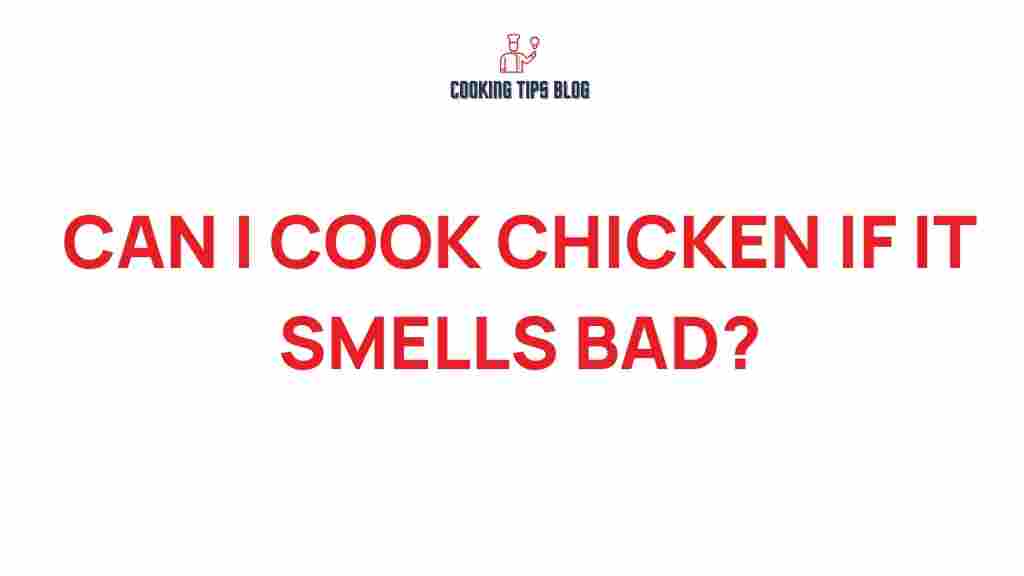Chicken Safety: Is It Safe to Cook Chicken That Smells Bad?
When it comes to food safety, few topics provoke as much debate as handling and cooking chicken. Many home cooks have faced the dilemma of whether to cook chicken that has an off-putting smell. The truth is, understanding the signs of spoilage is crucial for ensuring your health and safety in the kitchen. In this article, we will delve into the world of chicken safety, discuss the implications of cooking chicken that smells bad, and provide you with tips to handle chicken safely.
Understanding Chicken Safety
Chicken safety is a vital aspect of food preparation that everyone should take seriously. The United States Department of Agriculture (USDA) emphasizes that proper handling and cooking of chicken can reduce the risk of foodborne illnesses. It’s essential to know what constitutes safe chicken and how to identify potential spoilage.
Signs of Spoilage
Before deciding whether to cook chicken that smells bad, you must recognize the signs of spoilage. Here are some indicators that your chicken may not be safe to consume:
- Unpleasant Odor: Fresh chicken should have little to no smell. If it emits a sour or rancid odor, it’s likely spoiled.
- Change in Color: Fresh chicken typically has a pink hue. If you notice gray or green patches, it’s a sign of spoilage.
- Sticky or Slimy Texture: Fresh chicken should feel moist but not sticky or slimy. A tacky surface indicates bacterial growth.
- Expiration Date: Always check the sell-by or use-by date on the packaging. If it has passed, the chicken may not be safe.
What Happens When You Cook Spoiled Chicken?
Cooking spoiled chicken does not guarantee safety. While cooking can kill some bacteria, it may not eliminate all toxins produced by harmful pathogens, leading to foodborne illnesses. Symptoms may include:
- Nausea
- Vomiting
- Diarrhea
- Abdominal cramps
- Fever
These symptoms can manifest anywhere from a few hours to several days after consuming spoiled chicken, depending on the type of bacteria present.
Step-by-Step Process: Handling Chicken Safely
To ensure chicken safety, follow these steps when handling and cooking chicken:
1. Purchase Wisely
When buying chicken, always check:
- The sell-by date.
- Packaging for any tears or leaks.
- Color and texture.
2. Store Properly
After purchasing chicken, store it immediately in the refrigerator at a temperature below 40°F (4°C). If you do not plan to use it within one to two days, consider freezing it.
3. Thaw Safely
When thawing frozen chicken, do so in the refrigerator, in cold water, or in the microwave, never at room temperature. This helps prevent bacterial growth.
4. Wash Your Hands and Surfaces
Before and after handling chicken, wash your hands with soap and water. Additionally, clean any surfaces that come into contact with raw chicken.
5. Cook Thoroughly
Cook chicken to an internal temperature of at least 165°F (74°C). Use a meat thermometer to ensure it reaches this safe temperature throughout.
6. Store Leftovers Appropriately
If you have leftover cooked chicken, refrigerate it within two hours. Consume leftovers within three to four days for optimal safety.
Troubleshooting: What to Do If Your Chicken Smells Bad
If you find yourself questioning whether to cook chicken that smells bad, it’s best to err on the side of caution. Here are some troubleshooting tips:
- Smell Test: If the chicken has an off odor, do not cook it. Instead, discard it to avoid potential health risks.
- Visual Inspection: If the chicken appears discolored or sticky, it’s best to throw it away.
- Consult Resources: Check resources like the USDA’s Food Safety and Inspection Service for more information on food safety.
Common Myths about Chicken Safety
Several myths surround chicken safety that can lead to dangerous practices. Here are a few common misconceptions:
- Myth 1: Rinsing Chicken Makes It Safer: Rinsing raw chicken can spread bacteria to other surfaces. Cooking it properly is the only way to ensure safety.
- Myth 2: It’s Safe to Eat Chicken That Looks or Smells Fine: Just because chicken appears okay doesn’t mean it’s safe. Always trust your senses and adhere to storage guidelines.
- Myth 3: Freezing Kills Bacteria: Freezing may halt bacteria growth but does not kill them. Always cook chicken to the proper temperature.
Conclusion
In conclusion, chicken safety is paramount when preparing meals. Cooking chicken that smells bad is not safe and can lead to serious health risks. By understanding the signs of spoilage, practicing safe handling, and debunking common myths, you can ensure that your chicken dishes are both delicious and safe to eat. When in doubt, it’s always better to discard questionable chicken rather than risk your health. For more information on food safety, feel free to explore our detailed guides here.
Remember, a little knowledge goes a long way in maintaining chicken safety and ensuring a healthy kitchen environment!
This article is in the category Basic and created by Cookingtipsblog Team
